Tomic
The Tomic (トミック) is a Japanese 6×6 folding camera made by Tōkō Shashin in 1952–3. It contains a number of peculiar features, and was only made in a small number.
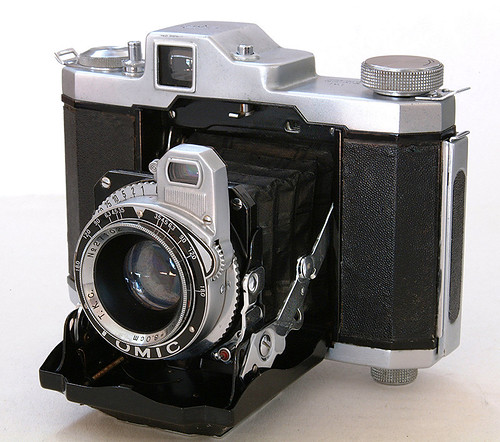
|
| image by Geoff Harrisson (Image rights) |
Description
Overall view
The Tomic is a horizontal folder, with folding struts inspired from the Balda products or from the Olympus Chrome Six. The viewfinder is contained in the top housing and is offset to the right, as seen by the photographer. It has two prongs at the top, giving parallax correcting indications. The film is advanced by a knob placed at the left end of the top plate. The folding bed release is placed in the middle, and the shutter release is at its usual location on the right. It has a screw collar that can be removed to fit a Leica-type cable release. There are strap fittings at each end. The back is hinged to the right for film loading and contains two green windows. The camera can take both 6×6cm and 4.5×6cm exposures, [1] the smaller format is achieved by inserting a clip-in mask at the film plane.
Specific rangefinder
The rangefinder is made of two parts, and is reminiscent of that of the early 6×6 Super Ikonta. The rear part is contained inside the body, above the bellows, and is hidden under the front door when the camera is closed; it has a small rectangular window and no moving parts. There is an arm attached to the lens casing, containing a rectangular optical element facing the left window. This moving element is driven by a small gear, which also rotates the front cell of the lens. The rangefinder coupling mechanism was advertised as "all-new",[2] and despite its similarity with that of the Super Ikonta, it is said to be based on a Japanese patent.[3]
Specific Gyrope shutter, Sygmar lens
The shutter is a synchronized Gyrope (B, 1–400), specifically designed for the Tomic.[4] It was advertised as a "revolutionary shutter, opening from all four corners",[5] and is said to have four sectors, shaped as ginkgo leaves.[6] The Gyrope shutter was certainly developed to counter the fall-off tendencies of simple lens designs, which is increased by the regular leaf shutters opening from the center.[7]
The lens is a C. Sygmar 8.0cm f/3.5, specially designed for the camera. The diaphragm is set by moving a lever attached to a rotating disc which has reverse-engraved numbers on it. They are displayed via a prism in a small window on top of the lens/shutter mount. The apertures marked are unusual as they are the old pre-war scale: f/3.5, 4.5, 6.3, 9, 12, 18. The distance scale is printed on the outer rim, and is surrounded by a fixed black ring with depth-of-field indications and the name TOMIC at the bottom.
Commercial life
The Tomic was announced in the July to October 1952 issues of Japanese magazines, and it was advertised from August 1952 to March 1953.[8] The September 1952 advertisement in Asahi Camera, placed by Tōkō Shashin, says that the camera is a new model, and does not give a price.[9] The November advertisement in Ars Camera was placed by the distributor Tsukada Shōji.[10] The Tomic is priced at ¥23,000, along with the Planet, a cheaper 6×6 folder made by Tōhō Kōgaku. While the two windows on the back are marked 6x6 and 4.5x6 the leather case (in the photo below) has the film sizes in inches. This perhaps indicates that some were made for export, probably to the USA.
Surviving example(s)
It is said that the specific shutter and rangefinder were unreliable, and that very few Tomic were made.[11] At least three surviving examples are known. One of them is pictured in Sugiyama, and lacks the small milled ring around the shutter release.[12] Another is in the collection of the JCII, and has this milled ring.[13] The other is pictured on this page.[14]
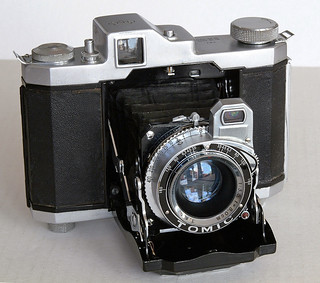 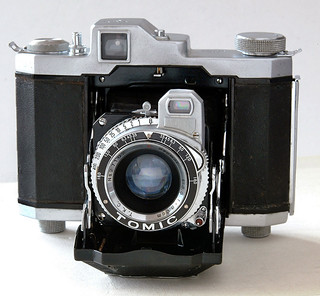 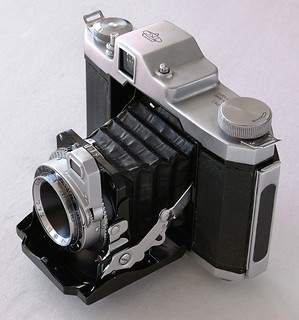
|
| images by Geoff Harrisson (Image rights) |
 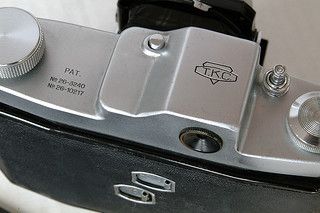 
|
| Gyrope shutter & aperture window, Top plate showing company logo & patent numbers, Case with format markings. images by Geoff Harrisson (Image rights) |
Links
In Japanese:
Notes
- ↑ Dual format: advertisements reproduced in Kokusan kamera no rekishi, pp.152 and 174.
- ↑ "斬新な機構に距離計連動装置": advertisement dated September 1952 reproduced in Kokusan kamera no rekishi, p.152.
- ↑ Japanese patent: Lewis, p.74.
- ↑ Gyrope name, specific to the Tomic: advertisement dated September 1952 reproduced in Kokusan kamera no rekishi, p.152. The shutter is called "Tomic" in Sugiyama, item 1421, and in Omoide no supuringu-kamera-ten, p.28, because of the TOMIC marking below the lens.
- ↑ "四隅から開く革新的シャッター": advertisement dated September 1952 reproduced in Kokusan kamera no rekishi, p.152.
- ↑ Four sectors, ginkgo leaves: Lewis, p.74.
- ↑ This logical explanation is found in Lewis, pp.74–5.
- ↑ Kokusan kamera no rekishi, p.356.
- ↑ Advertisement reproduced in Kokusan kamera no rekishi, p.152.
- ↑ Advertisement reproduced in Kokusan kamera no rekishi, p.174.
- ↑ Lewis, p.75.
- ↑ Example pictured in Sugiyama, item 1421.
- ↑ Example pictured in this page of the Center of the History of Japanese Industrial Technology, in Omoide no supuringu-kamera-ten, p.28, and in Lewis, p.74.
- ↑ Body number 52036, lens number 27102.
Bibliography
- Asahi Camera (アサヒカメラ) editorial staff. Shōwa 10–40nen kōkoku ni miru kokusan kamera no rekishi (昭和10–40年広告にみる国産カメラの歴史, Japanese camera history as seen in advertisements, 1935–1965). Tokyo: Asahi Shinbunsha, 1994. ISBN 4-02-330312-7. Item 626. (See also the advertisement for item 778.)
- Lewis, Gordon, ed. The History of the Japanese Camera. Rochester, N.Y.: George Eastman House, International Museum of Photography & Film, 1991. ISBN 0-935398-17-1 (paper), 0-935398-16-3 (hard). Pp.74–5.
- Omoide no supuringu-kamera-ten (思い出のスプリングカメラ展, Exhibition of beloved self-erecting cameras). Tokyo: JCII Camera Museum, 1992. (Exhibition catalogue, no ISBN number.) P.28.
- Sugiyama, Kōichi (杉山浩一); Naoi, Hiroaki (直井浩明); Bullock, John R. The Collector's Guide to Japanese Cameras. 国産カメラ図鑑 (Kokusan kamera zukan). Tokyo: Asahi Sonorama, 1985. ISBN 4-257-03187-5. Item 1421.